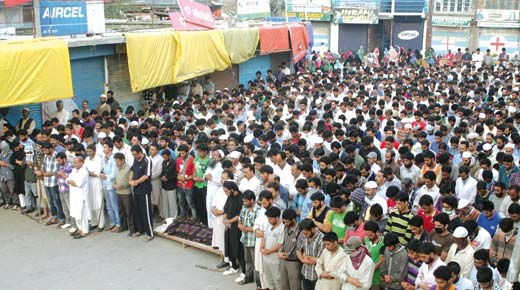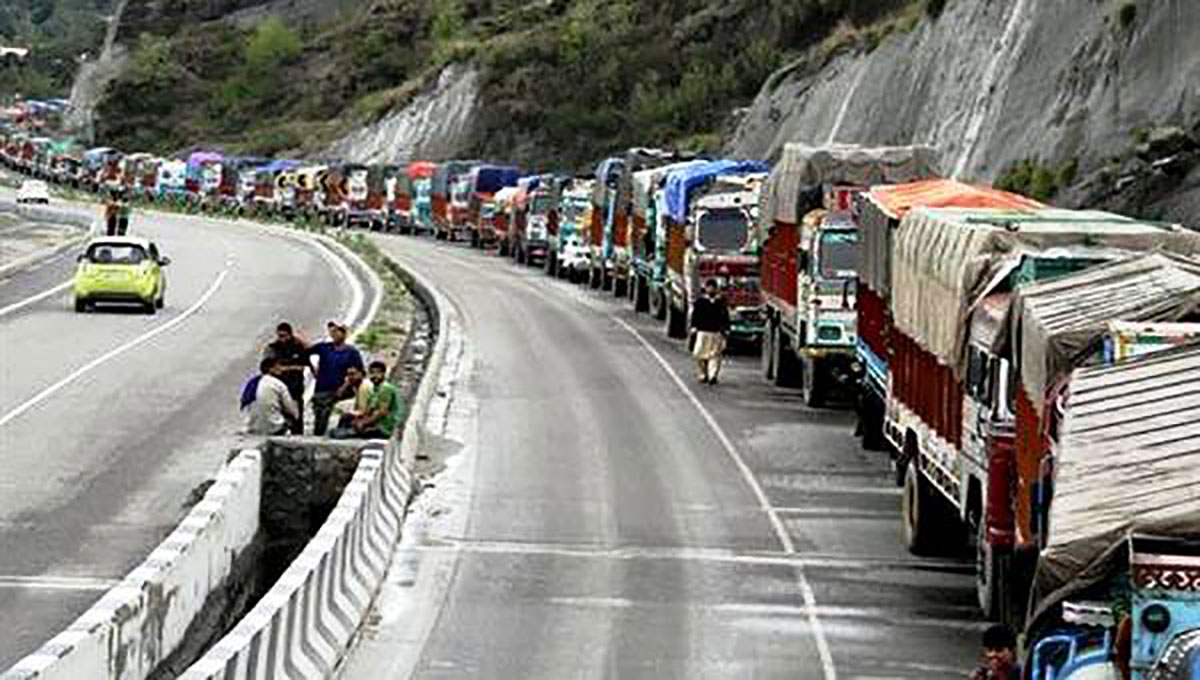 When he became the state’s youngest ever chief minister in the wake of 2008 unrest, little did Omar Abdullah know the complexity of the issues he would face after a ‘dream’ election catapulted him to power. Three years later what does his ‘mixed bag’ look like? Parvaiz Bukhari recaps.
When he became the state’s youngest ever chief minister in the wake of 2008 unrest, little did Omar Abdullah know the complexity of the issues he would face after a ‘dream’ election catapulted him to power. Three years later what does his ‘mixed bag’ look like? Parvaiz Bukhari recaps.

Omar Abdullah, the forty-something grandson of Sheikh Mohammad Abdullah and the third generation chief minister from Kashmir’s first political family completes three years in office. Depending on where you come from, it is either very complex or very simple to assess his performance so far. Many say he would be best remembered for the unflinching support he received from New Delhi in the face of abysmal popularity at home and the ‘watershed’ winter elections of 2008 that brought him into the high office in the first place. Others might say that Omar openly challenged the mighty army but lost the contest to the apprehensions of the security establishment or the ‘national interest’.
However, a fair way of assessing Omar Abdullah’s performance could perhaps be undertaken only by keeping in sight the source of his power and the limitations on the exercise of that power. And, that is where the limits to his accountability must be derived from.
Jammu and Kashmir is no ordinary state. Almost everything here is viewed in the security or ‘national interest’ paradigms. Not much polarizes the political class in India as the decisions of a Kashmir CM or the state government’s response to political events here. Omar’s attempt to remove AFSPA from some districts of the state is the most recent example of that and his helplessness or powerlessness as CM. He rediscovered that he had the power to call in the army in a ‘special’ situation but did not have the power to take the cover of a special, and unpopular, lawback from its deployment even in the districts where the army is not involved in anti-militancy operations anymore.
Just before the biannual Darbar was to move to the winter capital of Jammu, Omar made a very confident announcement that application of AFSPA would be removed from some districts – Srinagar, Budgam, Samba and Jammu – in a matter of days. This triggered a fierce debate not just between the state government and the defense establishment but within the central government as well. The army again hardened its position against Omar’s move. Such was the opposition from the army and the national right-wing political groups like the BJP that at one time the defense and the home ministries appeared on the opposing sides within the government. This despite the fact the all-powerful Cabinet Committee of Security had earlier recommended that AFSPA would slowly have to be withdrawn as the situation ‘improved’ in Kashmir.
 During the peak of the debate around the removal of AFSPA, Omar, as the highest elected official in the state, was to taste the audacity of top army officials in the meeting of the Unified Headquarters, responsible for over security management of the state, he was chairing to discuss his proposal. In a power-point presentation prepared by the Generals to argue against the removal of AFSPA it was reportedly said that ‘separatists, the ISI and the militants’ were the ones who wanted AFSPA gone from Kashmir. An angry Omar reportedly retorted during the meeting asking for a copy of the presentation. “I want to see where I fit (in the demand for removal of AFSPA),” he was quoted by the Hindu to have said. After having made an announcement for the removal of AFSPA the army almost clubbed him with the ‘separatists, the ISI and the militants’ as if in the spirit of defending its ‘holy book’.
During the peak of the debate around the removal of AFSPA, Omar, as the highest elected official in the state, was to taste the audacity of top army officials in the meeting of the Unified Headquarters, responsible for over security management of the state, he was chairing to discuss his proposal. In a power-point presentation prepared by the Generals to argue against the removal of AFSPA it was reportedly said that ‘separatists, the ISI and the militants’ were the ones who wanted AFSPA gone from Kashmir. An angry Omar reportedly retorted during the meeting asking for a copy of the presentation. “I want to see where I fit (in the demand for removal of AFSPA),” he was quoted by the Hindu to have said. After having made an announcement for the removal of AFSPA the army almost clubbed him with the ‘separatists, the ISI and the militants’ as if in the spirit of defending its ‘holy book’.
Omar then went literally door-to-door in the power corridors in New Delhi to drum up support for his idea of letting the ‘dividends of peace’ flow to the people of his state. He met with the home minister P Chidambaram, the defense minister A K Antony and the most powerful politician in the country Sonia Gandhi besides the army chief, but to no avail.
When the chief minister returned to Srinagar he said he had not announced a ‘decision’ about the partial removal of AFSPA but a mere ‘intention’ to do so. It was a revealing case of how little power a Kashmir chief minister wielded even in a situation where the army is supposed to be working in aid of the civil administration. In the ensuing days, the army created yet another specter of heightened ‘militant violence’ if AFSPA was touched. Once that happens, the issue enters the realm of ‘national security’ where the ‘political desires’ of the chief minister become irrelevant. The army went to the extent that if it loses the cover of AFSPA the country would be forced to grant Kashmir ‘independence’ soon.
Omar was overwhelmed with opposition to his ‘harmless’ and people-friendly ‘intention’. The ‘intention’ behind the removal of AFSPA came at a time when Omar was in the eye of a storm created by the custodial death of a National Conference worker, Haji Mohammad Yusuf, who had supposedly enjoyed a close relationship with the chief minister and his father and party president Dr Farooq Abdullah.
Many believed, and the perception still lives in some quarters, that the AFSPA debate was stirred to divert public and media attention from an event inside the chief ministers residence that culminated in Yusuf’s handing over to police by Omar himself and his junior home minister Nasir Aslam Wani and finally to his death in police custody.
The incident triggered such a political storm in the state that the principal opposition party, the PDP, started believing that the time to bludgeon the Omar-led coalition government out of the office had come – something that did not happen even in the face of the 2010 summer agitation when the chief minister’s credibility and popularity had hit abysmal levels both inside the state and in the mainstream Indian opinion.
When Omar occupied the top seat in the state government he enjoyed an image of a young and forward-looking and straightforward politician with a clean slate. But that image began taking measure hits soon. Initially, he felt comfortable advocating the people’s needs and demands in a securitized state.Earlier, as chief minister, he had an army camp removed from Bomai after villagers there protested the killing of two youth in an unprovoked firing incident during a festival at a Sufi shrine. That decision made him a lot of political capital. But Omar did not realise that a similar incident could happen soon again in Kashmir resulting in demands of removal of more army camps. And it did, in Budgam. But this time he felt forced to turn the popular demand down, saying it was not possible to have camps removed every time people made such a demand. He started falling into the same image slot as almost all his predecessors have found themselves in.
But what hit Omar’s carefully crafted media image, as the chief minister, in the wake of the 2008 ‘watershed’ elections, was his handling of the Shopian alleged rape and murder of two sisters-in-law. Although he punished the state’s intelligence chief for initially ‘misleading’ him, the way the case went on to be handled, first by the SIT of the state police and later by the CBI, Omar lost a major chunk of public sympathy he may have earlier enjoyed. The Shopian case ‘proved’ by the CBI investigation to be what the chief minister initially said it ‘looked like’– a simple case of drowning in a shallow stream – would be remembered in the people’s perception as one of ‘institutional denial’ of justice during Omar Abdullah’s stewardship of the state.
As the Shopian storm raged silently the situation inside Kashmir was becoming pregnant with despair. And then the Matchil faked encounter, in which three young men of Nadihal village of Handwarra were killed in cold blood by the army, was revealed by a rare police investigation. Omar initially again displayed courage and questioned the army saying it under the prevailing situation and laws like the AFSPA in force the army acted like the ‘judge, jury and hangman’ earning the displeasure of the mighty force. That incident of killing of civilians by soldiers for cash rewards and promotions was finally to become the grim background to what is now known as the 2010 summer unrest triggered by the killing of a schoolboy by a teargas canister fired directly at his head.
Omar oversaw the security establishment’s response to that mass outpouring of anger that has become a milestone in the troubled contemporary history of Kashmir. Police and CRPF action left more than 140 youth, including a girl, dead. Omar was widely criticized inside Kashmir as well as outside in India for having failed to reach out to his people and incompetent handling of a volatile situation. He was blamed for having presided over to the bloodshed of youth.

Pic: Arif Wani
At the peak of the 2010 unrest, most widespread as it was, Omar’s his family’s close confidante and senior minister in his government, Ali Mohammad Sagar said on a live TV debate that the CRPF were not respecting the CM’s orders and pleaded for the union home ministry to rein in the federal paramilitary force. Under immense pressure from within Kashmir and from New Delhi, Omar appeared tied to power and later his government said that Sagar’s comment about the CRPF was his personal opinion and the government did not share that view.
He did not stand up against the ‘brutal’ police and CRPF action and instead seemed to be content at having all the support from the UPA government and top leaders including Sonia Gandhi and her son Rahul Gandhi. By the time the government forces regained control of the Kashmir street Omar appeared almost totally in synch and agreement with New Delhi enhancing the impression that it was the center’s support that mattered much more than his appeal on the ground.
Omar’s mantra for staying in the chair promised for the entire six-year term to him by his ally the Congress party, remained all through that as long as himself, the defense ministry, the home ministry and the PMO ‘read from the same page’ his grip on power will remain. But along the way, in the last three years, Omar also realized that it is not the popular electoral mandate as much as the synch with New Delhi that will determine the limits of his power.
If the youngest ever chief minister of Jammu and Kashmir will credit himself with the ‘successful’ Panchayat elections and ‘devolution’ of powers to the village bodies in the spirit of strengthening ‘democracy at the grassroots level’, the people will also mark his chief ministership as very repressive, particularly during the ‘peaceful’ year of 2011 just gone by.
 The opposition PDP’s criticism and rhetoric notwithstanding Omar’s first three years as CM is a mixed bag perhaps characterised by a heavy and dark bulge that will make it difficult for him to carry a long way.
The opposition PDP’s criticism and rhetoric notwithstanding Omar’s first three years as CM is a mixed bag perhaps characterised by a heavy and dark bulge that will make it difficult for him to carry a long way.
And, warnings and now frequent controversial statements by state Congress leaders about the rotational chief ministership issue notwithstanding, if Omar continues in the chair for the remaining three years of the term it will not be as much because of the agreement his coalition partner, the Congress party has made with the NC but more because New Delhi prefers ‘stability’ and ‘peace’ in Kashmir more than the quality of governance or degree of democracy. However, in the end, a good politician is one who understands that longevity of relevance, as a player is more a function of the public perception than a remote source of power.
Arrival of a million tourists in a status quo ante situation has not been accepted as any measure of real peace. This kind of stability can at best be used to negotiate a political space in which solutions could be partnered with and real democracy nourished which does not happen either by occupying an office or by demitting it.















